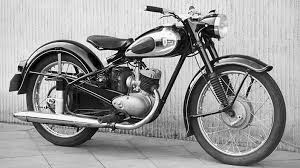


On July 16, 1930, Ing Zoller started building split-single two-stroke engines. It would be the engine that would make DKW a dominant racing motorcycle in the Lightweight and Junior classes between the wars.
The split-single system, or "Twingle", sends the intake fuel-air mixture up one bore to the combustion chamber, sweeping the exhaust gases down the other bore and out of the exposed exhaust port. The rationale of the split-single two-stroke is that, compared to a standard two-stroke single, it can give better exhaust scavenging while minimizing the loss of unburnt fresh fuel/air charge through the exhaust port. The belief is that a split-single engine can deliver better economy, and may run better at small throttle openings.
But there is a disadvantage to the split-single, for only marginal improvement over a standard two-stroke single, it is a heavier and costlier engine. That said, a manufacturer could produce a standard twin-cylinder two-stroke at an equivalent cost, so it was inevitable that the Twingle should become exTWinct.
Racing versions of this design were often mistaken for regular twin-cylinders, since they had two exhausts or two carburetors, but these are actually connected to a single bore in an engine with a single combustion chamber.
DKW had it's taste of fame and success with models such as the RT125, pre- and post-World War II. As reparations after the war, the design drawings of the RT125 were given to Harley-Davidson in the US and BSA in the UK. The Harley-Davidson version was known as the Hummer, while BSA used them for the Bantam.

